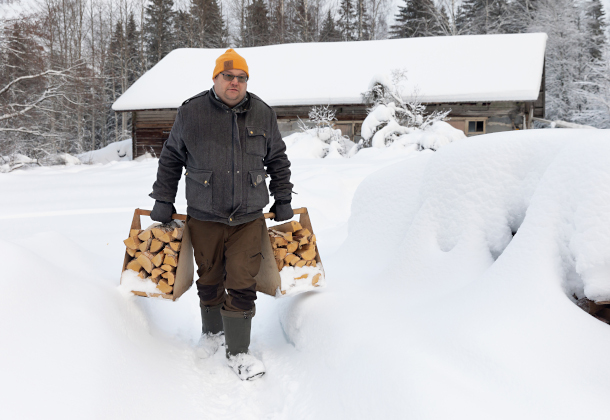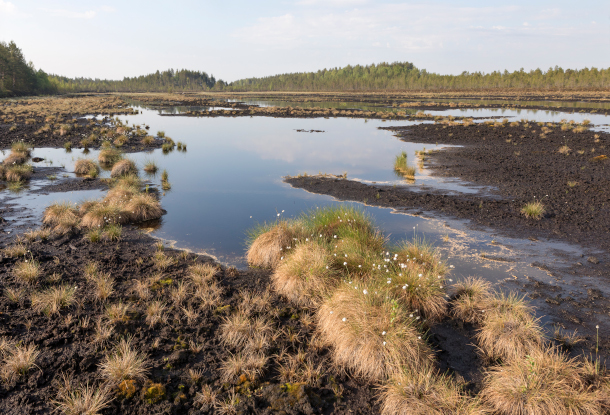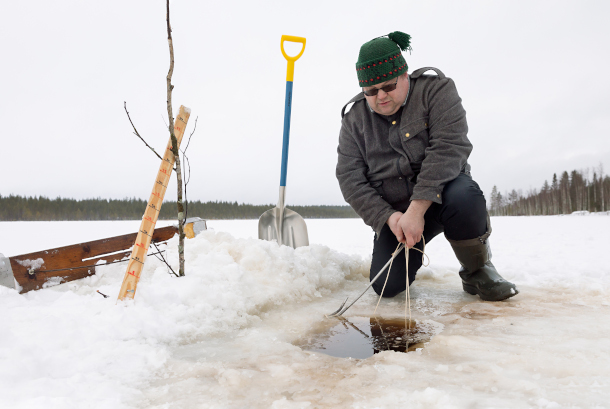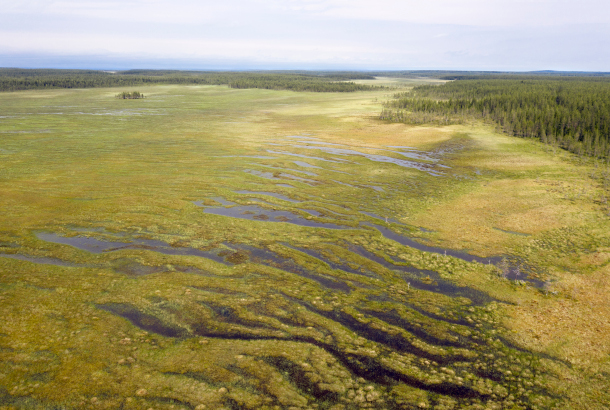Restoring Finland's Peatlands
Air Date: Week of May 19, 2023

Tero Mustonen, the 2023 Goldman Environmental Prize winner for Europe, carries firewood. (Photo: Goldman Environmental Prize)
Peat that’s burned for energy is a major greenhouse gas emissions source in Finland, which aims to become net zero by 2035. Peat mining is also a leading cause of habitat loss in the country. Tero Mustonen is the 2023 winner of the Goldman Environmental Prize for Europe for his efforts to stop peat mining and joins Host Steve Curwood to share how life is flourishing in the peatlands he’s helped restore.
Transcript
CURWOOD: There’s carbon capture and storage using high-tech, and then there’s nature’s version of carbon storage, known as the gas, oil and coal that was sequestered underground millions of years ago. Peat is an early step in the formation of some coals, and after the most recent ice age some peatlands emerged in the far north, including Finland. Peat can be burned for energy, and when the Finns were strapped for cash after World War two they started burning it. Even though peat provides less than 5 percent of domestic energy in Finland today it accounts for 14 percent of its global warming gas emissions. And in 2022 Finland adopted into law a target of not only becoming net zero by 2035 but also net negative by 2040, meaning that the country will need to absorb more CO2 than it emits. Some Finns are now working to stop peat burning and mining and restore degraded peat bogs, and among them is Tero Mustonen. He is the 2023 winner of the Goldman Environmental Prize for Europe for his efforts to restore the peatlands. This is the first time Finland has won the Goldman Prize. I asked him to tell us about the burning of peat in Finland and how much of it is there.
CURWOOD: So you won the Goldman prize for Europe for restoring peat bogs. Tell me about the history of burning peat in Finland, how much of it is there?
MUSTONEN: After the Second World War, when Finland lost the war in the Soviet Union and had to spring up its industries very fast. We had to come to terms how to do that because there was a lot of payments, we also had to pay to the Soviets. In 1940s, the government was thinking about what are our domestic sources of energy. So that's kind of where the founding ideas for really using the peat as an energy started. But then it came to a head in 1970s. With the energy crisis following the war in the Middle East, where a lot of countries were thinking in 1973, what are our domestic sources? And what could we do? So the large proliferation of peat mining actually expanded significantly. In terms of scale, it was probably in the order of 200,000 hectares, or something like that and then combined with that actual peat mining that removes the peat, there was also the large proliferation of peat lands being ditched and trained for forestry. So there was two big land uses that affected probably in the order of 5 million hectares in Finland, one third of Finland, used to be natural peatlands, and now we have lost in the order of about 5 million hectares.

Restored peatland in Karvia, Finland. (Photo: Mika Honkalinna, Goldman Environmental Prize)
CURWOOD: So one third of Finland was peat bogs that made it pretty squishy, I imagine. Hmm.
MUSTONEN: [LAUGH] There was a lot of swamp things around. Finland doesn't have oil and gas, we didn't have a lot of energy assets like Norway with its oil and gas and so on. But Finland, after the Ice Age, had 180,000 lakes and within those lake basins, you would find a lot of peatlands that accumulated after the Ice Age. That was kind of the post Ice Age environment that came to be in today's geographical location of Finland.
CURWOOD: So I want to be sure I heard you correctly. How many lakes after the Ice Age did Finland have?
MUSTONEN: 188,000.
CURWOOD: And the end of each of these lakes, I guess was a bog was a peat bog.
MUSTONEN: A lot of those, if not most, have their catchment area or basin, peatlands.
CURWOOD: So what inspired you to restore the peat bogs? What was the day that Taro woke up and said, You know what, I've got to do something about this?
MUSTONEN: Well, the day was 21st of June 2010. But before that was probably three decades of resigning to the fact that nothing can ever be done. We are losing these waters, we are losing these peatlands. But then there was an acidic discharge from a beet mine in my own village, operated by this company and it killed physically all the fish in our river. And then I felt my God, this is not the way to go. I was the head of the village at that time, I had the duty to voice our concern and indicate to the company that you can't kill our river. And that's, in a way when things started to change.
CURWOOD: Many companies just because somebody says stop, don't stop.
MUSTONEN: Yeah, I have found this is this is the case, unfortunately, around the world. What happened was that there was a first discharge of 2010, all the fish died, very acidic release 2.77 ph level, this is the same as battery acid. And we were able to show with laboratory, with the results, that they are the culprit. They are the company is the origin point of this very acidic waters. It was actually observed and monitored by the fishermen, not by the company or the state agencies, so it was the traditional knowledge of the village fishers the women and men were able to see the trouble firsthand. Okay, so then we informed this, it became public news, the company said, oh, we'll do so much better. And then six months later, in 2011, it happened again. I did two things, I phoned up the police and I also told the media. And there was then a lot of media that came down to the village and started to investigate what's going on. And you can argue that it was the public pressure, not the legal context or the authorities that enabled the company to decide for the first time in Finnish history to close down an active mine because of village resistance. And furthermore, they decided themselves to create these three original wetlands to control the acidity. And that's really where we started to see that the village and the village based NGO like Snowchane where I work can do something completely new. This opened the doors to the landscape rewilding program that we are having currently on the go.
CURWOOD: Now I understand that peat bogs take typically thousands of years to form. But yet you've restored quite a bit fairly quickly. How were you able to do that?
MUSTONEN: One of the early things we can do is to create ecologically functioning wetlands. We call it rewilding and in rewilding, you trust nature for the comeback. It's a little bit different connotation than simple, pure ecological restoration that's advanced by many parties. The notion of rewilding is that you also trust nature to determine what comes back and how the climate is new. So we have to be guided by nature in terms of what comes back. The good news is that these kind of very raw primary succession points like these wetlands become important later bird habitats. So there are some benefits. We can stop the soil based CO2 emissions, we can create safe havens, especially for wading birds and things like that. But as you say, these will not be primary peatlands for a long time, it will take at least a century for the phantom to be able to come back.

Tero Mustonen ice fishes in the Jukajoki River. (Photo: Goldman Environmental Prize)
CURWOOD: Talk to me about some numbers, how much has been degraded in terms of peatlands there in Finland, and how much have you been able to at least begin restoration for?
MUSTONEN: In terms of numbers, we can usually estimate that about 5 million hectares of peatlands have been lost to forestry teaching and peat mining in Finland. Currently, the latest numbers from Snowchange and our landscape rewilding program are at 52,000 hectares.
CURWOOD: Talk to me about the carbon the CO2 or the methane, that the peat bogs are taking up and sequestering. What are you finding?
MUSTONEN: Peatlands come to matter greatly in at least one aspect, which is that they are containing perhaps one-third of world's soil based carbon that needs to stay underground. So it's very important to take actions to keep this carbon or the ground in minimum. The good news is that if you restore peatlands, they also carbon sinks, they will throw down as you say, CO2, we often say that people know about Amazonian lungs of the world, but it's actually the northern peatlands that are kind of the second lungs. However, I would like to say perhaps that peatlands have their own inherent value. They are home to the European flyway of birds. They are beautiful places, they are the home of that diversity of life.

A conservation area in Ranua, Finland, owned by Snowchange Cooperative. (Photo: Mika Honkalinna, Goldman Environmental Prize)
CURWOOD: What advice would you give others who want to advocate for environmental protection and restoration?
MUSTONEN: No person is wrong. We all belong in our places. And even if you're in a city, or in the countryside in rural areas, you belong. You are not wrong. Humans are not the enemy. We just forgot that lesson. We are not the enemy of nature. We can coexist and we can thrive, or we still know what to do.
CURWOOD: What gives you hope now?
MUSTONEN: I recently visited the very first peatland we restored about a decade ago. Before we did our work, it was the home of two bird species. And now it's a diverse home of 220 different bird species. When I was standing at the bird tower last autumn, I felt how powerful the comeback can be. When we step back and yield to nature. Nature has its own agency and when we are able to realize that we'll let her do the things she needs to do we may have a fighting chance to come through all of this.
CURWOOD: Tero Mustonen is the European recipient of the 2023 Goldman Environmental prize, and President and Founder of the Snowchange cooperative in Finland. Thank you so much, and congratulations.
MUSTONEN: Thank you, Stephen. Thanks for talking with us and I look forward to the program. Thank you.
Links
Learn more about Tero Mustonen
Listen to our previous 2023 Goldman Environmental Prize interview.
Living on Earth wants to hear from you!
Living on Earth
62 Calef Highway, Suite 212
Lee, NH 03861
Telephone: 617-287-4121
E-mail: comments@loe.org
Newsletter [Click here]
Donate to Living on Earth!
Living on Earth is an independent media program and relies entirely on contributions from listeners and institutions supporting public service. Please donate now to preserve an independent environmental voice.
NewsletterLiving on Earth offers a weekly delivery of the show's rundown to your mailbox. Sign up for our newsletter today!
 Sailors For The Sea: Be the change you want to sea.
Sailors For The Sea: Be the change you want to sea.
 The Grantham Foundation for the Protection of the Environment: Committed to protecting and improving the health of the global environment.
The Grantham Foundation for the Protection of the Environment: Committed to protecting and improving the health of the global environment.
 Contribute to Living on Earth and receive, as our gift to you, an archival print of one of Mark Seth Lender's extraordinary wildlife photographs. Follow the link to see Mark's current collection of photographs.
Contribute to Living on Earth and receive, as our gift to you, an archival print of one of Mark Seth Lender's extraordinary wildlife photographs. Follow the link to see Mark's current collection of photographs.
 Buy a signed copy of Mark Seth Lender's book Smeagull the Seagull & support Living on Earth
Buy a signed copy of Mark Seth Lender's book Smeagull the Seagull & support Living on Earth

